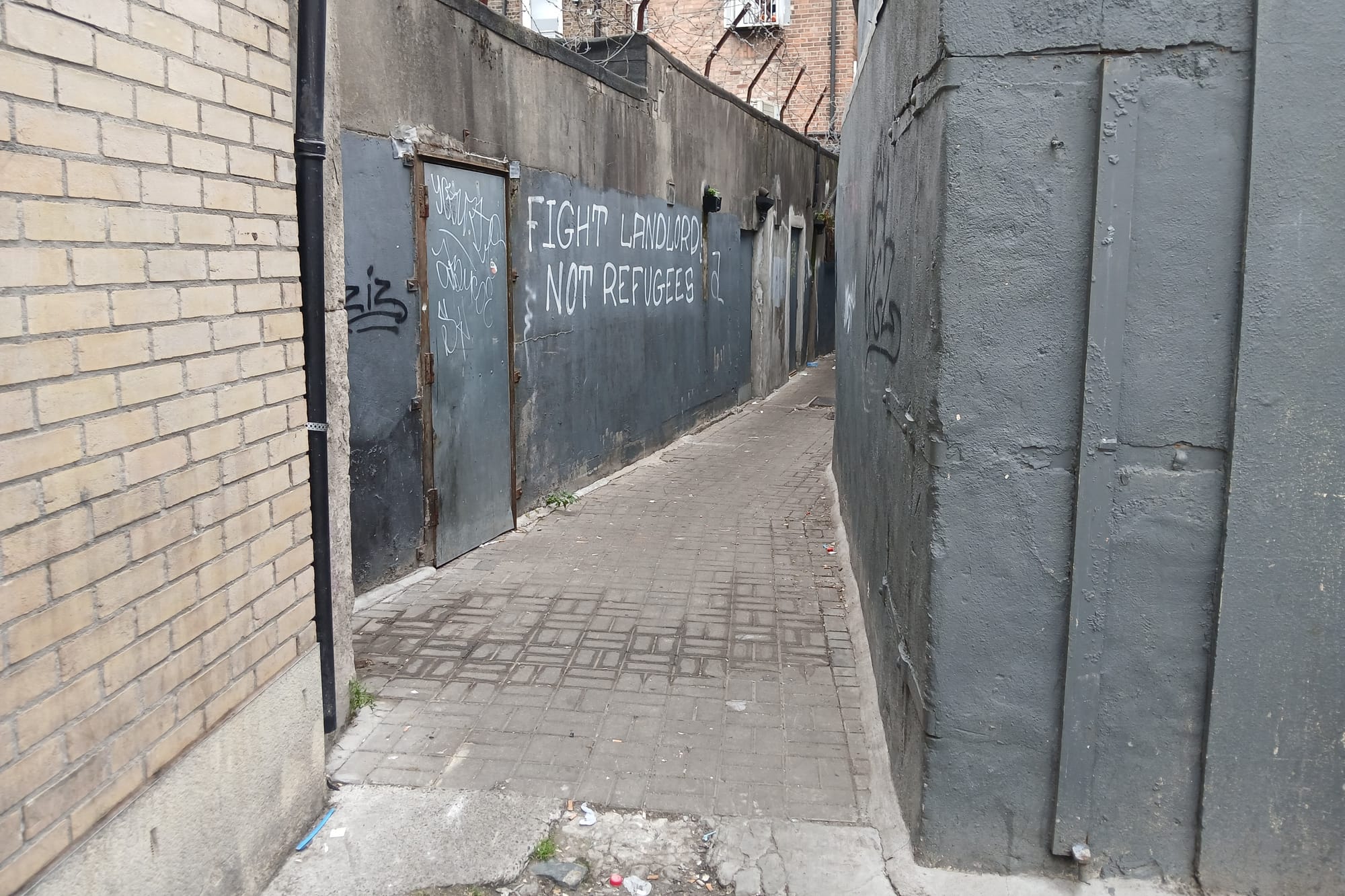What’s the best way to tell area residents about plans for a new asylum shelter nearby?
The government should tell communities directly about plans for new asylum shelters, some activists and politicians say.
It is just the latest route that Dublin councillors have proposed closing, following a similar arc of discussion.

A person walking along the south side of Thomas Street could easily miss the narrow opening between Mannings Bakery and toastie shop Griolladh.
But this gap is an entrance to Swan Alley, covered over at first into a tunnel, but opening up and widening out as it runs 50 metres south to Hanbury Lane.
On Monday morning, take-away rubbish littered the ground in the tunnel-y part just off Thomas Street.
A group of four men and women too busy to talk were gathered at the end of the tunnel, where the alley widened out and passed a car park at the back of an apartment building.
Out beyond the end of the alley, along Hanbury Lane, Diogo Lemos was just leaving the apartment he’s been renting for about five months now – heading off to college, he said.
The lane is dirty, there’s people hanging out in it on a daily basis, and sometimes he can hear fights at night, Lemos says. “It’s sad to see, it’s not the view I want to see, but no one ever bothers me,” he says.
He hadn’t heard that residents and businesses around the laneway have gone to the council and asked for it to be closed off. Or that local councillors voted last week to take the first step towards that closure.
“I don’t think the answer is closing the lane,” Lemos said. People who hang out in Swan Alley “are going to find another place, another area, probably around here anyway”.
Swan Alley is just the latest route in Dublin that councillors have proposed closing, after Harbour Court, Hardwicke Street, Ormond Place, and St Catherine’s Lane – a fact that councillors last week said they were acutely aware of.
At a meeting on 18 September of the council’s South Central Area Committee, Sinn Féin Councillor Máire Devine backed the closure.
“I just think this is an exercise in how to do things,” Devine said. “I mean, I’m not for closing off lanes … But this Swan Alley has been used to extreme anti-social.”
“The residents were putting up with just unacceptable criminal and antisocial behaviour,” Devine said. “Human fluids. Being accosted and being broken into. Being threatened. Being intimidated. Children not being able to play safely.”

Along the laneway, there’s a grey metal door with a computer-printed note on it. “THIS IS NOT COFFEE SHOP’S DOOR. THIS IS MY HOUSE’S DOOR. PLEASE DON’T DISTURB ME. I LIVE HERE.”
At the meeting, Labour Councillor Darragh Moriarty said he didn’t “want to be closing lanes in our city”, “but the residents in this instance felt that they had no option, and we have to kind of back them up”.
“I think this is a very unfortunate lane closure, that we shouldn’t be put in a position to make, and I think it’s happening too often now all over our city,” Moriarty said.
“Some of our laneways that, you know, should be bringing permeability to communities and be accessible to people are having to be closed because the local authority, the Gardaí can’t get a grip on the severe anti-social and criminal behaviour,” he said.
People Before Profit Councillor Hazel de Nortúin and Social Democrats Councillor Jen Cummins asked whether the closure could wait until the next meeting, so they could get more information on the issue.
But Moriarty and Devine urged their fellow committee members to move on it immediately – and the committee did.
The next step, council administrative officer Frank Murphy told the committee, is for the council to post signs at either end of the alley letting people know about the proposed closure.
“So that anyone who has any interest in it, if they have any observations or objections, that period’s open for four weeks,” he said.
The council will then take that feedback into account and make a final decision.
If it all goes ahead, “The public right of way would be extinguished and then gates would be put up,” said Murphy.
The council has tried in the past to improve the city centre’s laneways.
Back in 2014, the council and the Temple Bar Company had their Love the Lanes project, which aimed to use art and creativity to improve laneways.
In 2018, as part of the Reimagining Dublin One project, architect Seán Harrington was tasked with drawing up plans to improve the area’s laneways.
This year the council began rolling out those plans, commissioning murals, and looking at opening up laneways for people to play cricket in.
Devine, the Sinn Féin councillor, referenced these efforts at the meeting last week.
“I think we’re trying to reintroduce the Love Your Lanes concept done by Dublin City Council in different areas of the city in 2014, so we’ve got a few of them in mind, including Molyneaux Lane,” she said.
De Nortúin, the People Before Profit councillor, said there’d been requests to close Molyneaux Yard too – which the council rejected.
They “said no on the grounds of closing off public lanes isn’t what’s best for the city”, de Nortúin said.
She’d like more information from Murphy about the specifics of the plans to close Swan Alley to public use, and what it would be used for after the closure.
“So we can back up the fact that we are closing off lanes more and more as things escalate in the city”, de Nortúin said.
Get our latest headlines in one of them, and recommendations for things to do in Dublin in the other.